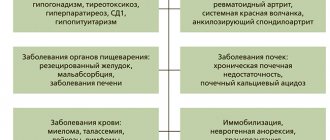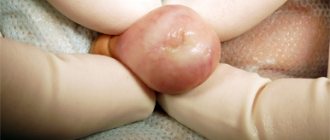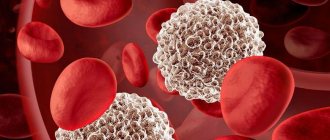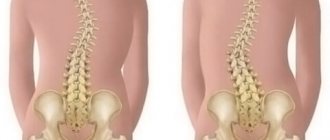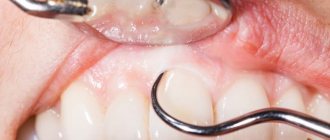Quick transition Treatment of primary immunodeficiency
Primary immunodeficiency (PID) is a heterogeneous group of rare, predominantly hereditary diseases characterized by disruption of one or more components of the immune system.
Such immunity disorders lead to increased vulnerability of the body to various pathogens, resulting in frequent and recurrent infectious diseases, the development of chronic and systemic diseases (autoimmune, cancer).
Types of diseases
This syndrome can be either primary (genetically determined) or secondary (appears due to external factors or diseases).
Primary immunodeficiency in children - what is it and where does it come from?
Congenital immunodeficiency (ID) in a child is something that develops due to genetic factors; these are primary disorders of the immune system. As a result, severe infections develop that quickly become chronic, and organs and tissues are affected by inflammatory processes. Without treatment, primary immunodeficiency leads to death in children from complications of various infectious diseases.
Symptoms of primary immunodeficiency may not be detected in children because the disease does not have unique features. This may be a simple but often recurring infection, for example of the lungs or ENT organs, or problems with the gastrointestinal tract, inflammation of the joints. Often neither parents nor doctors realize that all these problems are the result of a defect in the child’s immune system. Infectious diseases become chronic, complications appear, and there is no response to a course of antibiotics. Typically, severe forms of immunodeficiency are visible immediately after the birth of the baby or after some time. Source: Doan Thi Mai Recurrent infections in children - the risk of immunodeficiency // Pediatrician, 2021, vol. 8, special issue, pp. 109-110
It is important to distinguish primary immunodeficiency from AIDS. The second is a viral, acquired disease, and the primary form is already “implanted” into the body due to genetic defects.
Why does a child develop secondary immunodeficiency, and what is it?
Such a disease is also a disorder in the functioning of the immune system; it appears in children and adults and is not the result of defects in genes. Secondary immunodeficiency can be caused by a number of factors - external and internal. Any external unfavorable factors that disrupt the metabolic process in the body can lead to the development of such a pathology. The most common of them:
- poor environment, dirty air;
- ionizing radiation, microwave exposure;
- acute poisoning in chronic form;
- long course of certain medications;
- chronic fatigue, stress. Source: M.V. Kudin, S.A. Sergeeva, A.V. Skripkin, Yu.N. Fedorov Prevention of morbidity in children with secondary immunodeficiency in disadvantaged environmental regions // Bulletin of VolSMU, 2009, No. 1(29), pp. 87-95
All these factors have a complex effect on the body and all its systems, including the immune system. And such as ionizing radiation, selectively inhibit the hematopoietic system. People living in conditions of environmental pollution have reduced immunity, they are more likely to suffer infections, and the risk of developing cancer increases. .
Carrying out immunotherapy
After a complete diagnosis has been completed and the type of immunodeficiency has been determined, the immunologist selects an individual treatment regimen.
The use of immunotherapy (drugs for the correction of immunity) is aimed at strengthening the functioning of the immune system, correcting the imbalance of immune reactions, suppressing the aggression of autoimmunity, and pathologically active processes. It is also important to stimulate the parts of immunity that are impaired in a particular patient.
Prof. Ignatiev V. A.
Sources:
- M. Yesenaliev. Acquired immunodeficiency syndrome is the main problem of public health // Bulletin of AGIUV, 2013, No. 1, pp. 64-65.
- Yu.N. Fedorov, V.I. Klyukina, M.N. Romanenko, O.A. Bogomolova, A.N. Denisenko. Strategy and principles of immunocorrection and immunomodeling therapy.
- Raje N, Dinakar C. Overview of Immunodeficiency Disorders // Immunol Allergy Clin North Am. 2015 Nov;35(4):599-623. doi: 10.1016/j.iac.2015.07.001. Epub 2015 Aug 25.
Diagnostics of ID
A family history and complaints of the child (if he is not a newborn), an examination, as well as a number of laboratory tests are collected: molecular genetics, clinical blood test, etc.
Important! If the family already has a child with primary immune deficiency, then prenatal diagnosis is extremely important when carrying a second one.
Signs and symptoms of primary immunodeficiency are detected in children already in the first weeks of life. When a doctor collects anamnesis, he pays special attention to the frequent incidence of viruses and bacterial infections, to heredity aggravated by disorders of the immune system, to congenital malformations.
Often such pathology is detected much later and by chance, when other tests are performed.
The main methods for diagnosing both congenital and acquired disorders of the immune system:
- examination of the child, during which special attention is paid to the condition of the skin, as there may be fungal infections, erosions, dystrophy, ulcers, swelling of different parts of the body;
- blood tests - pathology is indicated by a violation of the leukocyte formula;
- special immunological studies;
- molecular genetic analysis.
Symptoms
The clinical picture of primary immunodeficiencies is very heterogeneous and depends on the type of disorder; it can include not only immunological disorders, but also gastrointestinal disorders, hematological and autoimmune diseases, atopy, and malignant neoplasms. In addition, diseases of each group of PIDs have overlapping symptoms and common signs of typical diseases.
The main distinguishing feature of PID is frequent, long-term, recurrent infections that are difficult to treat, as well as the so-called. opportunistic infections that are not dangerous for a person without immunodeficiency.
Symptoms of primary immunodeficiency may include:
- frequent and recurrent pneumonia, bronchitis, infections of the sinuses, respiratory tract, ear, mouth, skin infections, meningitis;
- delayed growth and development;
- gastrointestinal disorders (chronic diarrhea, malnutrition, malabsorption, chronic giardiasis, IBD, atrophic gastritis);
- autoimmune and autoinflammatory diseases (autoimmune thyroiditis, rheumatoid arthritis, systemic lupus erythematosus, dermatomyositis, type 1 diabetes);
- hematological disorders (autoimmune hemolytic anemia, neutropenia, thrombocytopenia).
Some patients with PID may present with a constellation of associated symptoms of the disease. For example, patients with chronic granulomatous disease are characterized by recurrent bacterial or fungal infections, as well as chronic inflammation of the gastrointestinal tract and respiratory tract. Patients with Wiskott-Aldrich syndrome (an X-linked recessive disorder) are characterized by symptoms such as eczema, recurrent bacterial infections, and thrombocytopenia.
Compared with people with a healthy immune system, patients with PID have a higher risk of malignancies: lymphoma, leukemia, digestive tract tumors, and virus-induced cancers.
Treatment of the disease
The primary form of the disease involves:
- avoiding contact with possible sources of infection.
- during periods of remission, the child can and should lead a normal life, maintain hygiene, and attend an educational institution.
- if there is a threat of infection, broad-spectrum antibiotics are prescribed.
- If there is an effect, the child should be treated for about 3-4 weeks while taking antiviral and antifungal agents. Sometimes antimicrobial treatment lasts for years.
Immunodeficiency can be corrected using immunoreconstruction, replacement treatment, and immunomodulators. In the primary form of the pathology, immunoglobulins are used; in the secondary form, immunotropics, replacement therapy, and immunization are used.
In case of primary pathology, it is extremely important to isolate the child from all sources of infection. When there are no exacerbations of infections, the child can lead a normal life. In case of primary immunodeficiency against the background of a general deficiency of antibodies, children cannot be vaccinated against:
- measles;
- mumps;
- polio;
- rubella;
- chicken pox;
- tuberculosis.
Those living with the child can only be vaccinated with inactivated vaccines.
Antimicrobial treatment consists of taking broad-spectrum antibiotics. If there is no rapid response to therapy, the drug is changed. If there is an effect, then the child should take the antibiotic for at least 3-4 weeks. Medicines are administered intravenously or parenterally. At the same time, antifungal drugs are prescribed and, if indicated, antiviral, antiprotozoal, and antimycobacterial drugs. Antimicrobial therapy can even be lifelong.
For influenza against the background of ID, oseltamivir, remantadine, zanamivir, amantadine, and neuraminidase inhibitors are usually prescribed. If a child gets chickenpox or herpes, acyclovir is prescribed; parainfluenza requires taking ribavirin. Before dental treatment or surgery, the child must take a course of antibiotics to prevent infection.
In cases of severe secondary or primary T-cell ID, Pneumocystis pneumonia should be prevented, depending on blood test results. For this, doctors usually prescribe trimethoprimsulfomethaxozole.
Important! Any medications should only be prescribed by a doctor; self-medication is deadly for a child!
Methods for correcting immune deficiency:
- replacement treatment;
- reconstruction of immunity;
- immunomodulation.
Immunoreconstruction involves transplanting bone marrow or stem cells obtained from umbilical cord blood. In case of primary ID, replacement therapy most often involves taking allogeneic immunoglobulin, which in recent years has been commonly administered intravenously.
Treatment of children with primary ID with common defects in antibody production
In this case, replacement therapy with immunoglobulins, which are administered intravenously, and antibiotics is carried out. Immunoglobulins are administered once every three to four weeks for life. Continuous antibiotic therapy is needed to prevent bacterial infections.
When a bacterial infection worsens, broad-spectrum antibiotics administered parenterally are prescribed. In case of hyper IgM syndrome and common variable immune deficiency (CVID), you need to constantly take antifungal and antiviral drugs. They can be assigned in courses. This is determined by the doctor individually. If a child has X-linked hyper IgM syndrome, then a bone marrow transplant from an HLA-identical donor is indicated.
Signs of immunodeficiencies
In immunodeficiencies, the main manifestations are severe bacterial, fungal or viral infections. We are not talking about banal colds, but about serious conditions: persistent sinusitis, recurrent pneumonia, multiple abscesses, fungal infections of the skin, mucous membranes and intestines, herpetic rashes. The more severe the stage of immunodeficiency, the more serious the manifestations.
Doctors distinguish five groups of PID depending on the damage to one or another part of the immune system:
- damage to humoral immunity;
- combined;
- phagocytosis defects;
- cellular problems;
- pathology of complement systems.
PID can be suspected based on a set of certain signs, but the diagnosis is confirmed in the laboratory, according to an immunogram, and in the case of HIV, by identifying antibodies to human immunodeficiency. Key features include:
- presence of PID in family members, death from infections at an early age;
- recurrent purulent otitis (more than 8 cases per year), two or more sinusitis;
- two or more pneumonias in a year;
- lack of effect from taking standard antibiotics used for more than 2 months;
- severe complications after vaccination with live vaccines;
- recurrent purulent processes of the skin and soft tissues (boils, abscesses);
- identification of two or more systemic infections with meningitis, sepsis, osteomyelitis;
- recurrent systemic candidiasis in patients older than one year;
- severe atypical infections (for example, Pneumocystis pneumonia).
These phenomena can complement long periods of low-grade fever, repeated infections with the transition to chronic, recurrent forms, ineffectiveness in the treatment of infections according to standard regimens, decreased performance, and constant asthenia. But a full diagnosis with an examination by an immunologist and the study of a detailed immunogram is important. Source: RajeN, DinakarC. OverviewofImmunodeficiencyDisorders // ImmunolAllergyClinNorthAm. 2015 Nov;35(4):599-623. doi: 10.1016/j.iac.2015.07.001. Epub 2015 Aug 25..
Objectives of immunological examinations:
- confirmation of immunodeficiency states;
- determination of the severity of violations of one or another part of the immune system;
- individual selection of immunocorrective therapy and assessment of its effectiveness;
- making a prognosis, monitoring therapy, preventing complications.
Treatment methods for secondary ID
Immunotropic therapy is mainly used, which can be of different directions:
- active immunization;
- replacement therapy;
- taking immunotropics.
The choice of immunotropic therapy depends on how acute the inflammatory-infectious process is and what immunological defect is identified. When the symptoms of the disease subside, vaccine therapy can be used for prevention.
Immunoglobulins administered intravenously are used as replacement therapy. Their main active ingredient is special antibodies obtained from donors. Immunoglobulins containing only IgG are often prescribed.
Immunotropic treatment of secondary ID
Using immunomodulators, the effectiveness of antimicrobial therapy can be increased. Immunomodulators should be part of complex therapy together with etiotropic treatment of infection. The doctor calculates the regimen and dosage individually.
Immunological monitoring should be carried out while taking immunomodulators. If the infection is in an acute stage, immunomodulators are used with caution. Otherwise, you can cause a severe general inflammatory response and septic shock as a result. Source: G.A. Samsygina, G.S. Koval Problems of diagnosis and treatment of frequently ill children at the present stage // Pediatrics, 2010, v. 89, no. 2, pp. 137-145
Prevention methods
ID is easier to prevent than to treat. It is important to remember that the condition of the child directly depends on how correctly the pregnancy was planned. If one of the parents has problems with immunity, he must undergo special procedures to exclude a similar pathology in the child.
In the first six months of life, only breastfeeding is recommended, because breast milk contains all the necessary elements that contribute to the development of full immunity. If there is no lactation, you need high-quality artificial mixtures, but always supplemented with multivitamins.
Sources:
- Doan Thi Mai. Recurrent infections in children - the risk of immunodeficiency // Pediatrician, 2021, v. 8, special issue, pp. 109-110.
- M.V. Kudin, S.A. Sergeeva, A.V. Skripkin, Yu.N. Fedorov. Prevention of morbidity in children with secondary immunodeficiency in disadvantaged ecological regions // Bulletin of VolSMU, 2009, No. 1(29), pp. 87-95.
- G.A. Samsygina, G.S. Koval. Problems of diagnosis and treatment of frequently ill children at the present stage // Pediatrics, 2010, v. 89, no. 2, pp. 137-145.
The information in this article is provided for reference purposes and does not replace advice from a qualified professional. Don't self-medicate! At the first signs of illness, you should consult a doctor.
Prevention
A healthy lifestyle and good nutrition are the first steps to a healthy immune system. Moderate physical activity, in particular cardio exercises, is also important for the child. The key preventive measure is to take care of the body: taking immunostimulants and multivitamin complexes, protecting against infection, eating vegetables and fruits.
You should also avoid emotional stress and stress. Any infections should be diagnosed and treated only by specialists.
Prices
| Name of service (price list incomplete) | Price |
| Appointment (examination, consultation) with an allergist-immunologist, primary, therapeutic and diagnostic, outpatient | 1750 rub. |
| Consultation (interpretation) with analyzes from third parties | 2250 rub. |
| Prescription of treatment regimen (for up to 1 month) | 1800 rub. |
| Prescription of treatment regimen (for a period of 1 month) | 2700 rub. |
| Consultation with a candidate of medical sciences | 2500 rub. |
| Allergen-specific immunotherapy (ASIT) - maintenance course (excluding the cost of the drug) | 8100 rub. |
